At the end of December, I decided to go vegetarian for the month of January. And, to be completely honest with you, I technically I opted for pescetarianism, since I allowed myself to eat fish on occasion throughout the month.
Pescetarianism is a diet that excludes all land-based meat and poultry. I aimed to eat plant-based, vegetable-full meals throughout the month, with the occasional inclusion of fish.
Admittedly, this decision was partially motivated by the several week long holiday gluttony. More than that though, I was eager to remove meat from my diet after watching Michael Pollan’s “In Defense of Food” documentary, which was released on PBS in late December. The documentary is structured around Pollan’s now famous manifesto on eating:
“Eat food. Not too much. Mostly plants.1”
The film sheds light on a variety of topics, but the sections on the benefits of a plant-based diet and the state of the modern meat industry particularly resonated with me. That being said, I had excellent practice working through my huge CSA share this summer and really loved eating a primarily plant-based diet then. However, that being said, I would be modifying my diet a bit in order to adapt to the absence of meat. I started the month by turning to some of my favorite cookbooks and blogs to source some veggie-full meals to leave me satisfied during the cold, January days.
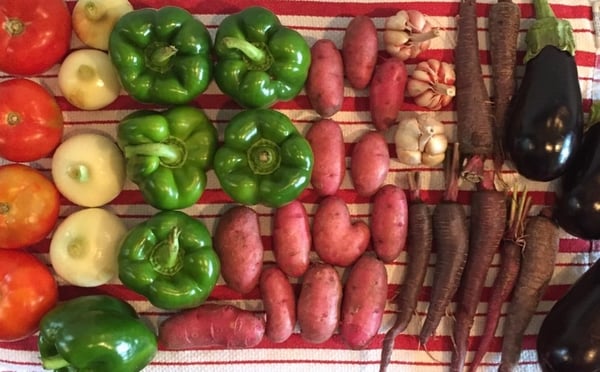 A snippet from one week of my veggie-plenty CSA this past summer
A snippet from one week of my veggie-plenty CSA this past summer
Overall, the month has been going quite well, and I have been enjoying expanding my repertoire in vegetarian and vegan cooking. Fortunately, when I realized that there was a spare seat in the Seafood 101 class up in Lincoln Square, I thanked myself for allowing fish into my diet this month and signed up!
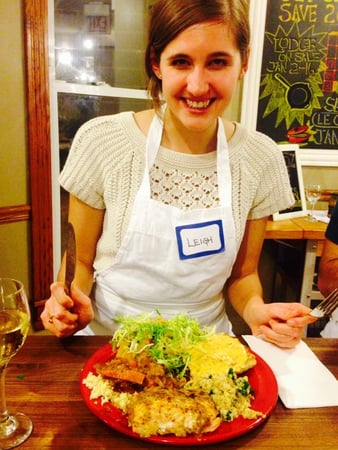 This winter, the Seafood 101 class menu has students preparing three dishes featuring various types of seafood and shellfish. Over the course of the night, we prepared Mustard-Glazed Salmon with Sautéed Spinach and Quinoa, Shrimp and Scallop Tagine with Olives and Roasted Peppers and Sautéed Bass with Golden Beet-Orange Salad and Harissa Aioli. Did you catch all of that? It certainly was a lot of accomplish over the course of three hours.
This winter, the Seafood 101 class menu has students preparing three dishes featuring various types of seafood and shellfish. Over the course of the night, we prepared Mustard-Glazed Salmon with Sautéed Spinach and Quinoa, Shrimp and Scallop Tagine with Olives and Roasted Peppers and Sautéed Bass with Golden Beet-Orange Salad and Harissa Aioli. Did you catch all of that? It certainly was a lot of accomplish over the course of three hours.
I was particularly excited to take the class because, while I love to try new recipes, I am always a bit hesitant to cook with fish at home. A small selection of the worries that routinely plague me as I consider cooking fish at home include (but are certainly not limited to!): “What if I overcook the fish?” and “Will it leave my house smelling like a fish market?” Needless to say, I needed the help of our Seafood 101 chef-structor Sara and accomplished team of assistants to overcome my worries.
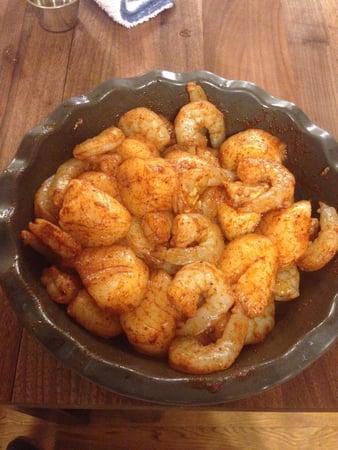 My fear of overcooking the fish was absolved by learning how to prepare fish using three different methods. First, we learned how to perfectly sear both sea scallops and shrimp in order to get that beautiful golden sear. Did you know that in order to ensure a good sear, you should use cooking oil with a high smoke point (like grapeseed or coconut oil) and make sure the oil is gently smoking before adding the fish to the pan? Also, avoid the temptation to move the fish around the pan when searing. Add the fish to the pan and do not move it until it is ready to be flipped! We undercooked the scallops and shrimp just slightly since we finished them off in the tagine-like stew right before we ate.
My fear of overcooking the fish was absolved by learning how to prepare fish using three different methods. First, we learned how to perfectly sear both sea scallops and shrimp in order to get that beautiful golden sear. Did you know that in order to ensure a good sear, you should use cooking oil with a high smoke point (like grapeseed or coconut oil) and make sure the oil is gently smoking before adding the fish to the pan? Also, avoid the temptation to move the fish around the pan when searing. Add the fish to the pan and do not move it until it is ready to be flipped! We undercooked the scallops and shrimp just slightly since we finished them off in the tagine-like stew right before we ate.
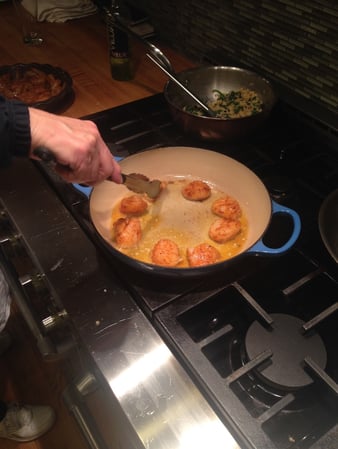 We also learned the easiest way to prepare salmon ever, in my opinion! Chef Sara had us broil the salmon in the oven and then taught us a very handy way to tell if the salmon is done by touch. The salmon is done when it is a bit resistance to the touch, but is not too firm. You want your salmon to be flaky, opaque in color on the outside and just cooked through.
We also learned the easiest way to prepare salmon ever, in my opinion! Chef Sara had us broil the salmon in the oven and then taught us a very handy way to tell if the salmon is done by touch. The salmon is done when it is a bit resistance to the touch, but is not too firm. You want your salmon to be flaky, opaque in color on the outside and just cooked through.
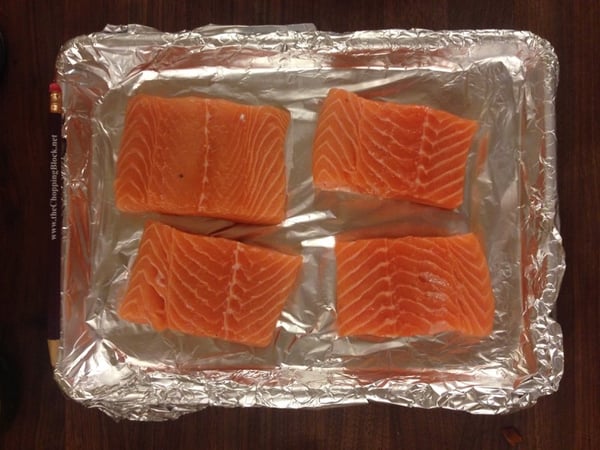 The salmon, before it was glazed with mustard and broiled
The salmon, before it was glazed with mustard and broiled
Finally, we sautéed the sea bass on the stove following the same searing technique we learned for the scallops. Make sure the pan is hot and the oil has a high smoke point. Then, sear the “presentation side” of the fish first, until golden brown. Then, we added butter and thyme sprigs to the pan and basted the fish in this herbal butter to infuse additional flavor as the bass finished cooking.
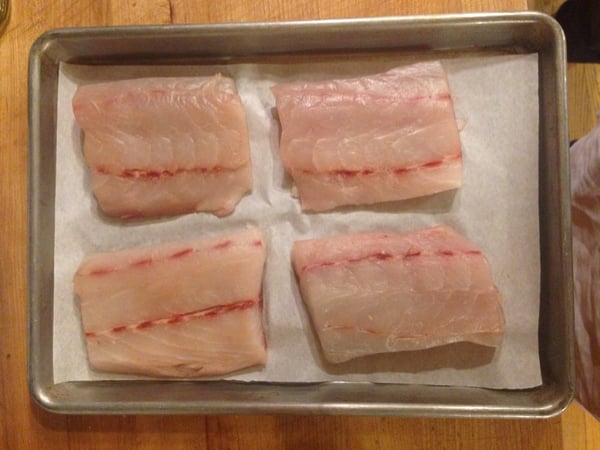 Sea bass, pre-sear
Sea bass, pre-sear
Needless to say, over the course of the night we prepare a feast fit for a pescetarian! My fear of the house smelling like a fish market completely disappeared since I learned three great, fool-proof ways to prepare seafood that left the kitchen smelling like a spice market. I brought home my tattered & food-stained recipe packet and will certainly be pulling it out when I prepare golden tilefish, from Hooked on Fish, for dinner this week.
Hooked on Fish is a seafood CSA that delivers fresh, sustainable fish to the Midwest. Both of The Chopping Block locations serve as pick-up points for this fresh seafood and each week, the great team at Hooked on Fish throws in an extra portion of fish for our staff to try! I was lucky enough to snag the sample this week and look forward to trying this great and unique piece of fish at home using my newfound skills.
If you want to expand your skills in working with seafood, I would highly recommend taking an upcoming offering of Seafood 101. The Chopping Block also offers other cooking classes in the “101” series, including Meat 101 & Chicken 101. This set of classes will help you expand your culinary skills working with a particular protein group and give you a set of recipes to take home and share with friends and family. Perhaps it will help you, as it did me, overcome a particular kitchen trepidation or even just try out a new set of ingredients and skills on your own!
1Pollan, Michael. In Defense of Food: An Eater's Manifesto. New York: Penguin, 2008. 1. Print.











